BS 476 Guidance on Performance of Paint Finishes in Standard Tests
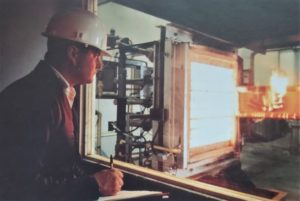 Guidance on Performance of Paint finishes in Standard Tests
Guidance on Performance of Paint finishes in Standard Tests
- Paint systems cannot be tested in isolation; they must be tested as they will be used in practice applied to a representative substrate.
- Test results can vary dependent upon the nature of the substrate to which they are applied. If paint is applied to a timber substrate, for example, it is likely to give a worse performance than if it is applied to a plasterboard substrate.
- It is not possible to generalise substrates as ‘combustible’ or ‘non-combustible’. A test result on a steel substrate, for example, may be worse than on a plasterboard substrate because Delamination of the coating from the steel occurs. Conversely a better result may be obtained on the steel substrate because it has different thermal characteristics than the plasterboard. Generalisations are dangerous.
Small differences in substrates can significantly affect the test results; the thermal conductivity, specific heat and density of the substrate all influence the test performance. A thinner steel substrate, for example, could give worse results than a slightly thicker steel substrate. With combustible substrates thicker substrates tend to give an improved performance during the early stages of the test due to increased thermal capacity) but poorer performances during
- the later stages due to additional fuel availability.
- The preparation of the substrate (e.g. cleaning, primer, undercoat systems) can affect the test results. The degree of adhesion of the coating system under the test conditions can be very important.
- The thickness of the coatings can be significant. In general the thicker the coatings the worse the result, but again generalisations can be dangerous.
- Apparently minor variations such as colour, method of application, time between application of coats and temperature/humidity conditions during the application process can all affect the test results.The development of a meaningful test programme to give the widest possible information on the paint system is therefore vital. Control of the application process is also important to ensure that the coating systems applied in practice are as similar as possible to the situation which was tested.
- Previously Painted SurfacesIt is not possible to confidently predict the spread of flame and heat release properties of coatings applied to previously painted surfaces. The existing paint finishes may be old and the effectiveness of their adhesion to the substrate or between coatings may be poor. In general, existing gloss paint systems tend to be the greatest problem and this is influenced by miniscule deposits of dirt which are difficult to remove, even by thorough washing. These cause trapped air layers which can lead to insulation/delamination problems. The combination of gloss and emulsion systems can also lead to poor performance, underlying emulsion coatings acting as an insulating layer. On the other hand it is possible that the properties of the old paints may have improved with ageing. Some paint manufacturers have conducted series of tests to investigate the properties of multi-coat systems, usually with modern paint formulations and these are usually accepted by specifiers as satisfactory evidence. The only way, however, is to remove all previous coatings and apply new systems to the stripped substrate.
Health and Safety Executive (HSE) Guidance
| PPE (Personal Protective Equipment) | 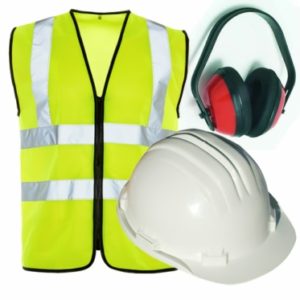 |
|---|---|
| https://www.hse.gov.uk/toolbox/ppe.htm | |
| Fire Safety |  |
| https://www.hse.gov.uk/construction/safetytopics/processfire.htm | |
| Riddor (Report injuries, diseases and dangerous occurrences) | |
| https://www.hse.gov.uk/riddor/index.htm | |
| Manual Handling | |
| https://www.hse.gov.uk/simple-health-safety/training/index.htm | |
| Asbestos | 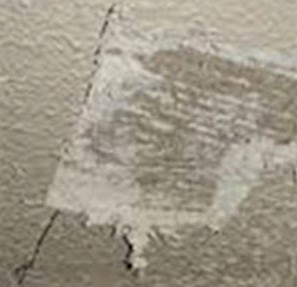 |
| https://www.hse.gov.uk/asbestos/index.htm | |
| Working at Height | 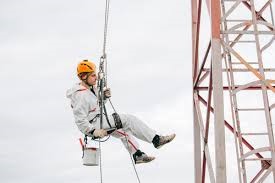 |
| https://www.hse.gov.uk/construction/safetytopics/assess.htm |
Carbonation of Concrete
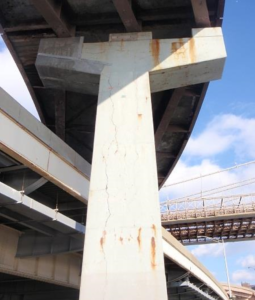 Carbonation of concrete.
Carbonation of concrete.
Carbonation of concrete is caused when moisture penetrates through porous areas of the structure allowing carbon dioxide to react with calcium hydroxide in the cement. (calcium carbonate).
When mixed with water the calcium carbonate forms a paste and can lead to corrosion (rust) of the steel reinforcing bars (Rebars).
As the corrosion builds up the the swelling can cause the concrete to fracture and ultimately breakaway.
For minor works the following solution may be considered but for any major works a structural engineer should be consulted.
Solution.
Where carbonation has occurred, all defective concrete should be removed and the exposed steel bars should be cleaned to remove all corrosion; followed by priming the steelwork with an anticorrosive primer.
All defective areas of concrete should then be made good as required and allowed to dry.
Painting.
An anti-carbonation coating should be applied in accordance with the manufacturer's instructions.
Suppliers of anti-carbonation coatings include.
Andura Coatings. https://www.andura.com/contact
New Guard Coatings Limited. https://newguardcoatings.com
Dulux. https://www.duluxtradepaintexpert.co.uk
Johnstones Paints.https://www.johnstonespaint.com/
Hardwood - Varnishes and Translucent Wood Finishes
Hardwood New
Varnishes and Translucent Stain Finishes.
While hardwoods are often allowed to weather naturally others prefer to treat the wood with either varnish or translucent wood stains.
Preparation.
All surface contaminants should by the most appropriate means followed by sanding down with suitable grade of glass- sand or garnet paper to prove a smooth surface.
Any visible resin around knots or sap residue should be removed and the surface wiped over with methylated spirit. When dry two thin coats of a white shellac
knotting.
Clear shellac should be used over any knots or sap residue.
All making good should be carried out with an appropriate wood filler and tinted to match the surrounding surface and sanded down.
Painting.
Apply one sealer coat and two full coats of the selected coating following the manufactures instructions
Note: If a normal coloured shellac knotting is used the shade will mirror through any subsequent clear or tinted finish.
Linseed oil putty should not be used for glazing or filling. Alkyd based sealants are recommended
Any discolouration of the bare wood due to weathering or water attack can be difficult to remove but treating the area with Oxalic Acid may remove the discolouration.
See: Problems and remedies Flaking of Stained wood finishes.
For further product information:
https://www.liberon.co.uk/product/palette-wood-dye
https://www.zinsseruk.com/product
Graining Tool Box

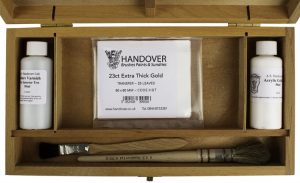
For further information on Graining tools and equipment:
H S Handover Ltd. Tel: 0207 2415877 - www.handover.co.uk
Gilding Tool Box
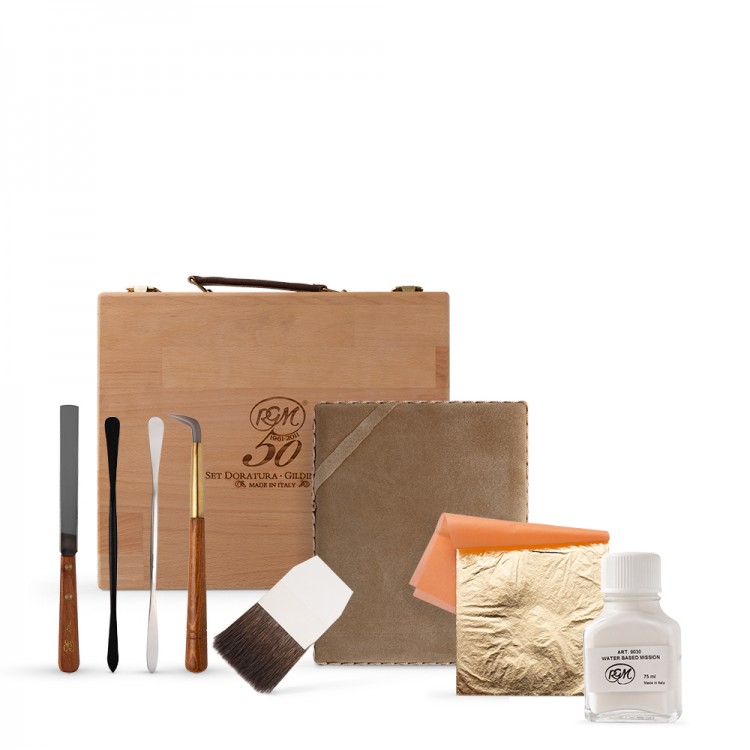
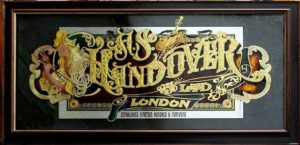
For full information on Tools and Equipment contact: A S Handover Ltd at: http.//www.handover.co.uk
Corroded Aluminum
Aluminium Corrosion
Cause

Although naturally resistant to corrosion when untreated aluminium is exposed to the external weathering a thin layer of oxide forms on the surface and enhances the resistance to corrosion.
However, this thin layer of oxide while being insoluble in water and resistant to some chemicals, it does not prevent the aluminium from loosing its glossy appearance and becoming dull.
Corrosion attack can occur if aluminium comes in contact substrates such as new concrete and other building components which have a alkaline content. Additionally, contact with other metals such as copper, lead, iron and copper naphthenate used as a wood preservative should also be avoided. Contact with sulphuric and hydrochloric acids along with chlorinated based solvents should also be avoided.
Remedy
See: Specification for Galvanised steel.
Broken Colour Techniques
Special Effects
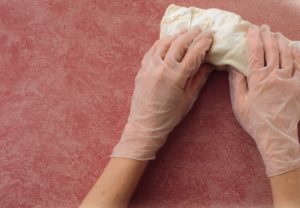
Rag Rolling.
This effect is obtained by rolling over a newly applied coat of glaze a onto a previously applied base colour with either clean rag, or polythene twisting the rolling motion to produce a marble type appearance.

Stippling
A decorative effect achieved by applying a wet coat of glaze over a base coat colour and tapping the surface with a stippling brush.
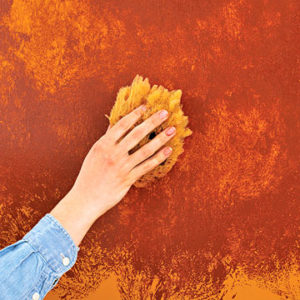
Sponging Off
This paint effect is achieved by using a slightly moist natural sea sponge which is tapped across the newly applied coat of glaze removing some of the newly applied wet glaze coat.
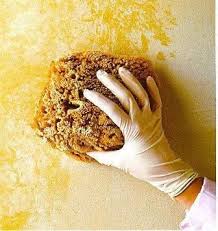
Sponging On
This design is created by using a natural sea sponge which is then dipped into the glaze then tapped over the surface turn the hand in different directions to produce the required pattern and texture.
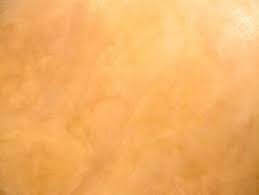
Colourwash
This mottled effect is achieved by applying a glaze coat over a coloured base coat in different directions then with a brush lightly glide over the surface to soften the appearance.
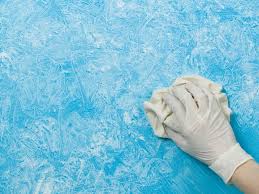
Bagging
This is effect is achieved by taking a crunched up piece of polythene to form creases and tapped onto the wet glaze coating.
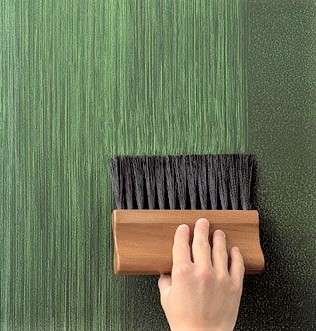
Dragging
This is a paint effect is produced using a dragging brush ( as in graining) which is pressed into the wet coating of glaze to form straight lines.
Frottage
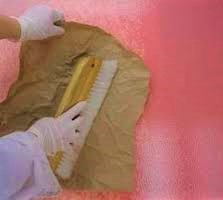
This effect is created by taking lining paper (800 grade) crunched up then opened up and laid out and placed over
a wet coating of glaze and finely smoothed over with a brush.
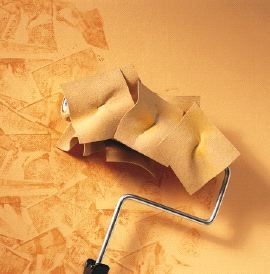
Leather Roller
This type of roller is formed by taking cut pieces of chamois leather screwed into a roller sleeve. Once formed the roller is then used to run over a wet coating of glaze in various directions to produce the required pattern.
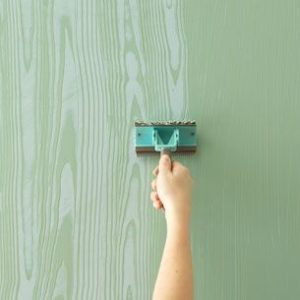
Woodgrain effect
This grain effect is produced by using a graining rocker.
See. Broken Colour Toolbox under Tools and Equipment and Specifications -Broken Colour Techniques
Blistering
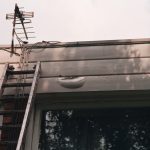
Blistering
Cause
Generally blistering is caused by moisture ingress into the underlying substrate. In time this builds up behind the paint coating resulting in blisters forming and in many cases, when broken, contain water.
In other cases blisters can form in and around wood knots and these can be as a result of gases from hardwood knots and sap.
Solution
The cause of the water ingress should be determined and rectified.
Note: Where wood knots are present then these should be either cut out and replaced with sound wood or two pack wood filler and suitable primer. For hardwood surfaces a spirit based aluminium wood primer could be used.
Shellac knotting will not resolve blistering problems as it is only designed to isolate the tannic acid, preventing it coming into contact with oil based alkyd paints to preventing discolouration. (see yellowing)
Complete removal of all the existing coatings and repaint with a standard system for wood.